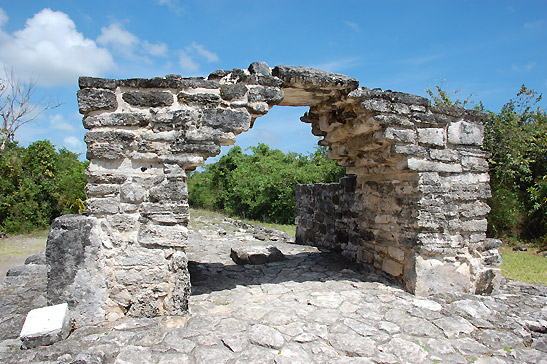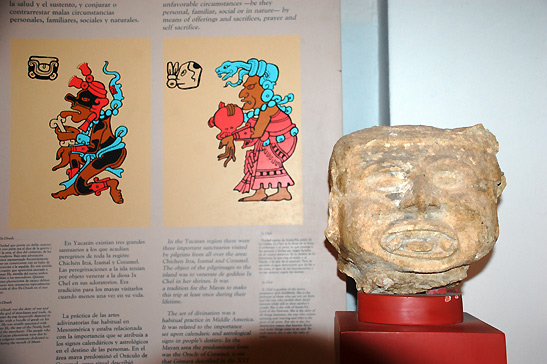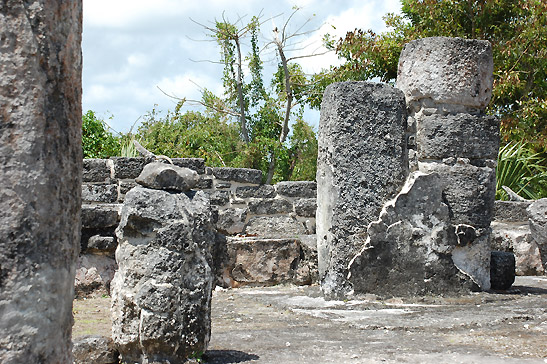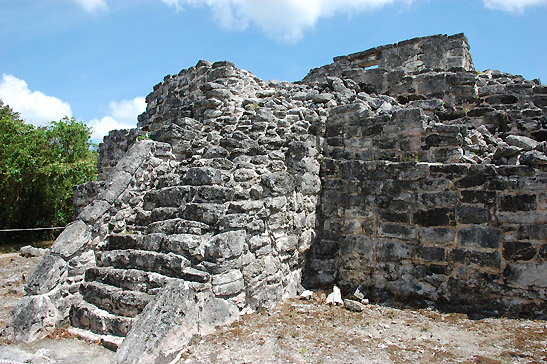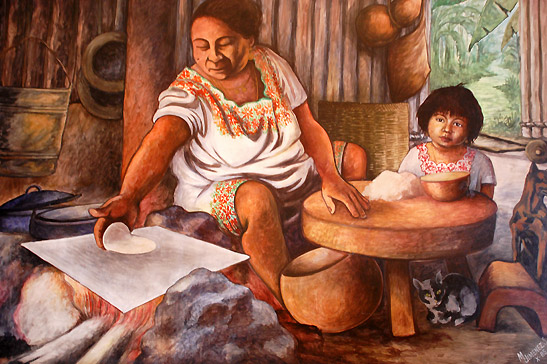 |
 |
|
 |

|
Inside
Cozumel
A Different World Story and Photos by Ken Walker
Only a handful of visitors really get inside Cozumel, where history replaces hype and time loses its importance. If you're not an inertial iguana or comatose cruiser, head inland by scooter, rental car or taxi, and discover what's under Cozumel's skin. About 11 miles toward the center of the island from the main port city of San Miguel de Cozumel lies an important Mayan site, not as eye-popping as Chichen Itza or Tulum, but spread out over about as much ground. It's the ruin the Spaniards called San Gervasio, named for reasons not now apparent for the Second Century Christian martyr Saint Gervase. Today, it is visited only by resident iguanas, tourists with a yen for Mayan history, and the occasional maintenance worker. Two thousand years ago it was a thriving religious center, dedicated to the worship of the goddess Ixchel. Between 100 B.C. and the Spanish invasion in the mid-1600s, Mayan women were drawn here to pay homage to one of their favorite deities.
Arrive at the ruins with plenty of bottled water, a hat, rain gear, insect repellant, and $6 or so in pesos for the entrance fee and state tax. As you enter, you face a stylized Mayan arch topped by a flat capstone -- as opposed to a keystone, which was unknown to the Maya -- , inside which lies an altar for initial offerings to Ixchel. Past the arch stretches the sacbe (white stone road) leading to the ceremonial center. Ixchel, generally translated as "She of the Rainbows," was the goddess of midwifery and medicine. Some scholars believe she also represented weaving, rain, and the waning moon. In any event, she is represented in the Dresden Codex (one of a very few surviving Mayan documents) as an elderly jaguar goddess with a coiled serpent headdress, emptying a jar of water at her feet.
The Spanish Bishop Diego de Landa, on whose orders the conquistadors burned all the Mayan books they could discover as "instruments of the devil." wrote of Ixchel in his History of the Yucatan as "the goddess of making children." In her feast month, de Landa wrote, shamans and healers brought forth divination stones and medicine bundles containing small idols of "the goddess of medicine whom they called Ixchel." By the time the Spaniards saw Cozumel first-hand, it was the custom for Mayan women to make a pilgrimage to her sanctuary on Cozumel to plead for a fruitful marriage. Vestiges of more than 40 of her temples are spread out over the extensive site, and small personal idols representing Ixchel are still being discovered. The ceremonial center is entered through a narrow gateway between standing stones. Today the stones are stark and bare, but in Mayan times they were covered with plaster daub, which in turn was painted with rich primary colors, predominantly red. Roofing was of thatch, supported by wooden beams and poles.
To the left as you enter the center stands the Round House. Some locals will tell you it was the residence of San Gervasio's lord, with the obligatory temple of Ixchel on top. Could be. But it could also have been an astronomical observatory and temple to Ehecatl, Mayan god of the wind. Structures almost identical to this are part of the archaeological record at many other Mayan sites.
Seeing all the ruins at San Gervasio involves a lot of walking but no hills. As you wander among the structures, it is easy to imagine the throngs of reverential Mayan women, expectant in both senses of the word, whose footsteps preceded your own on the same ground. You may also imagine the awe felt by the ancient visitors when they heard (as many archaeologists believe they did) the voice of Ixchel issuing from a giant statue of the goddess, articulated by a hidden priest. Back in town, in the small Museum of the Island of Cozumel on Rafael Melgar Avenue, is a modern painting honoring motherhood, showing a Mayan parent making tortillas with her daughter.
If you earn the confidence of modern Mayan women, you may discover that despite honest acceptance of Catholicism, aspects of the ancient religion have survived. Belief of the intercession of Ixchel in modern Mayan life is more common than one might think, and may still pass from generation to generation. On an emotional and historical level, my visit to Cozumel
left me far more impressed than many trips to grander and more popular
sites. So do visit Cozumel, for the people, the diving, the beaches,
and the local food, but for a sentimental pot of gold, don't skip San
Gervasio's lady of the rainbows. |
|
Ken, amazing that pieces of this culture remain. Thanks for
sharing it with us.
Thank you, I so enjoyed reading about one of the remote ABC
island of delights...its an inspiration to bank on...and goat stew with tripe?...hmmmm.
Your story reads like a wondrous, exotic, nature fare to feast on for tourists!
Caves, desert, the old windmill and so many other things to do! Thanks Ken! * * * * Awesome photos Ken! You have a good eye--especially liked the
composition of your Hooiberg shot from the Casibari Rocks vantage point. Your
piece is excellent at portraying the range of potential tourist experiences
available in Aruba. And from your descriptions, it is fairly obvious you are
a very interesting guy who doesn't just stay on the beaten path...(anyone who
allows public viewing of that underwater portrait has my immediate respect!)
So I did find myself wondering...are you always this objective? I'd kind of
like to get a totally slanted version from someone like you!
|
This site is designed and maintained by WYNK Marketing. Send all technical issues to: support@wynkmarketing.com

|







